Arigan/The Beginning
 This page is needs images. Help plz. This page is needs images. Help plz. |
The Beginning is the first era of Arigan which spans from the emergence of the three beginning species of fauna through the end of the third thread. While there were many microscopic forms of life in Arigan's rich waters, only three became visible to the naked eye. These were the Skrelp, the Felg and the Burz.

Environment
Progenitors
Burz: Flying, carnivorous invertebrates which had difficulties with taking off from the ground. They reproduced by laying a single egg, usually on the leaf of a Fern.
Felg: Felgs were aquatic scavengers. They used smell-sensitive pores on their heads to identify dead bodies in the water, Skrelp or Burz. The sharp "tooth" at the front of their mouths was used for scraping off bits of flesh. They would reproduce by laying large clutches of externally fertilized eggs.
Skrelp: A small and primitive herbivore species. It fed with mouth tendrils and used its sense of smell to find patches of algae to feed on. It reproduced in large numbers via external fertilization of eggs.
Fern: The common fern was a photosynthesizing plant with a single root. Given ample sunlight, a single sprout could be incredibly far-reaching.
Thungus: A fungus which would develop a fruiting body for producing spores.
Burz Evolution
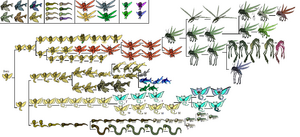
Perch Burz
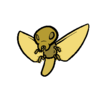
Legged Burz
Status: Extinct
progenitor: Burz
-> Armored Burz
-> Diving Burz
An early species of Burz, the Perch Burz gets its name from its ambush hunting behaviors. They would hang onto the fronds of Ferns hanging over bodies of water, and wait for something to swim past, at which point they would drop down into the water and latch onto their prey and bring it to shore. These Burz would fiercely defend their hunting leaves from others of their species that would want to take it for themselves. Those which were able to defend their leaves and were well fed were desirable mates. The egg would be layed on the underside of the male's leaf.
The hair-like projections on the legs of Perch Burz were used for cleaning their wings, allowing for easier flight after crawling back out of the water.
Armored Burz

Armored Burz
Status: Extinct
progenitor: Perch Burz
-> Emburz
Armored Burz evolved from the tough competition Burz faced from other Burz. Over time, they developped gnarled horns on their heads and a harder, more complete shell on their bodies and thicker mandibules. Along the way, they had also evolved spear-like claws on their forelimbs. Burz with larger, more complete shells reproduce more easily. When Skrelps became harder to catch, said competition had increased even more.
Emburz

Emburz
Status: Extant
progenitor: Armored Burz
-> Unknown
An offshoot remaining near the pools of the species' origin adapt a new chemical formula from the venom of their predecessors, a viscous fluid rich in sugar and nutrients that glows brightly in dim light. Large groups of Emburz hypnotise water-dwelling creatures with their rhythmic dance, causing them to surface, becoming easy prey. They have also developed more pointed chitin on their lower limbs, allowing them to skewer low-hanging parasites and eat them, while also better able to grab surface-bound meals.
Diving Burz
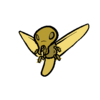
Diving Burz
Status: Extinct
progenitor:Perch Burz
-> Duburz
-> Canniburz
This species of Burz earns its name from its method of hunting. The hydrodynamic wings of the Diving Burz, coupled with the height from flying over the water allowed them to take deeper plunges into the water, thus allowing them to hunt prey further away from the shore. This hunting method frees them from relying on plants growing out over the water.
Duburz

Duburz
Status: Extinct
progenitor: Diving Burz
-> Durrd
Some Have evolved a second pair of wings for mobility to outmaneuver their prey Duburz Have mildly and has formed a more orange tinge in their bodies, These orange Duburz have a distinct armor not like armored Burz that only covers their heads
Durrd

Durrd
Status: Extinct
progenitor: Duburz
-> Grasper Durrd
-> Venom-Beak Durrd
The Durd as they are now classified as have developed a gland preventing them from local environmental toxins Though their eyes once bare, They now possess vertical eyelids protecting their sight Some Durd's anti-toxin glands mutate, and in addition to rendering them immune to airborne toxins, it concentrates them, causing them to excrete this concentrated cocktail as a form of paralytic venom from their beaks. These Venom Durds develop a lazier method of hunting to their non-venomous cousins. They swoop in, latch on, and peck their victims, envenoming them. Then return to the air and wait for the victim to succumb before landing and devouring them.
Grasper Durrd

Grasper Durrd
Status: Extinct
progenitor: Durrd
-> Hunter Durrd
After an eon, the Durrds begin to develop primitive graspers. What started out as a mutation causing multiple limbs turned into a beneficial adaptation. Too bad these critters aren't smart enough to utilize this advantage...yet.
Hunter Durrd

Hunter Durrd
Status: Extinct
progenitor: Grasper Durrd
-> Spore Durrd
-> Stilt Durrd
-> Swift Durrd
As the numbers of Durrds increases, so does competition. More and more often, durrds have to fight for their kills against other members of their species, as swarms of them descend upon prey killed off by the venom of the initial attacker.
Because of this competitive pressure, a lineage of durrds emerges that has specialized into stealing kills of other durrds, as well as quickly flying away with it's own kills. Both of these maneuvers are possible due to the grasping claws these durrds have developed on their two hind legs, as well as due to their streamlined, and agile body shape. They are also slightly larger than other durrds.
These durrds often hide in the fern foliage, monitoring their environment with their keen eyes. Upon spotting either vulnerable prey, or a kill of an other durrd, these fast hunters burst from their hiding place, and snatch the kill with their limbs, and if necessary, bite it with their venomous beak in order to quickly subdue the prey.
Their bigger bodysize, and more energy consuming hunting methods make these durrds somewhat less active than other durrd species. They spend large majority of their time hiding within fern plants, in order to consume less energy while they wait for the next opportunity to feed.
Spore Durrd

Spore Durrd
Status: Extinct
progenitor: Hunter Durrd
-> Furry Durrd
The Durrd have evolved a series of pores that emit a gas with identical properties to their the emit from their beaks venom. Durrds often use this venom as a chemical to sense suitable mates. Those they seem unworthy often will end up as the Durrds next mea
Furry Durrd

Furry Durrd
Status: Extinct
progenitor: Spore Durrd
-> Surud
-> Clurrd
The Monsoon that affected Arigan also affected the Durrd. With the occasions of the water level rising, Many Durrd went to higher ground, Though formidably cooler an environment, Most duurd adapted by growing hairs on their body to preserve heat
Surud

Surud
Status: Extant
progenitor: Furry Durrd
-> Unknown
Due to the cooling climate, suruds develop thicker "fur" coating that helps them protect themselves against the cold. When the weather cools down, these fuzzy suruds gather into their nests and pile up, vibrating their wing muscles rapidly in order to generate heat that is then trapped within their fluff. Even when out in the cold weather, the fuzz of the suruds helps them maintain enough bodyheat for relatively active hunting and foraging. This allows them to seek food even during the cold season, where they face less competition from their relatives.
During extremely cold times, the suruds will descend to a semi hibernation like state, where their activity slows down significantly, and they no longer leave their nest. They instead spend most of their time in sleep like state, relying on the insulating nest structure, their fuzz and the steady vibrations of their wings to keep them from freezing.
During warmer seasons, the excess fuzz is shed off, and used as construction material for their nests.
Clurrd

Clurrd
Status: Extant
progenitor: Furry Durrd
-> Unknown
Over time the Durrd of the short legged variety and part of their diets became slightly lighter in their tones, They lost their thin hairs but small extrusions appeared near their surface, Their First pair of arms formed another 'finger' in their graspers and their 2nd pair of arms shortened into 2 segments. still able to use both pairs of rear legs to travel this gave the Clurrd the ability of holding a tighter grip on fruits and prey
Stilt Durrd

Stilt Durrd
Status: Extinct
progenitor: Hunter Durrd
-> Flightless Durrd
-> Fird
With the water level risen many Durrd develop longer hind legs to increase the distance between themselves and the water. Sepecializing in grabbing debris or prey floating on or near the surface they quickly escape with their catch and feed in the saftey of their ferns.
Flightless Durrd

Flightless Durrd
Status: Extinct
progenitor: Stilt Durrd
-> Stridurd
The Long Legged Duurd eventually lost its wings and gained a longer beak, These were due to a fact that it's long limbs sometimes caused problems reaching towards the food when its graspers could not grab it. its rear two legs are primarily for locomotion
Stridurd

Durrd
Status: Extant
progenitor: Daburz
-> Unknown
The Wading Durrd, tired of falling over into the hungry jaws of underwater predators, develops long sword-like claws, acting as a third pair of legs to help maintain their balance and prevent being bowled over by the Strongtrunk Paddlers.
Fird

Fird
Status: Extant
progenitor: Stilt Durrd
-> Unknown
Some Long Legged Durrd begin to fish from a top of the floating Thungus. Eventually these Durrd develop a pointed spear, used to impale small water dwellers who reside at the surface.
Swift Durrd

Swift Durrd
Status: Extant
progenitor: Hunter Durrd
-> Unknown
The long beaked durrds have also adapted to the changing times, becoming even faster aerial hunters, who can snatch small fliers with their sharp claws straight from the air.
Over time, the venom the ancestors of these hunters used to posses has weakened, as these durrds started favoring more aggressive, and swift hunting tactics, that often involve spearing their victim with their sharp beak, and ripping it apart with their claws.
Venom-Beak Durrd

Venom-Beak Durrd
Status: Extant
progenitor: Durrd
-> Unknown
While toxins are all well and good, so many of the Venom Durd's prey items are developing hard shells for protection. Thus those with the sharpest beaks get the most prey, leading to Venom Durds with longer, sharper beaks, for cracking the shells of toughter prey.
Canniburz

Canniburz
Status: Extant
progenitor: Diving Bu008
-> Unknown
Some of the original Perch Burz gets outcompeted in food. So they have taken to hunting other Burz, including themselves - say hello to CanniBurz. They have better mandibles and claws to hold prey, but they still can't crack the Armored Burz.
Longtail Burz
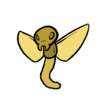
Longtail Burz
Status: Extinct
progenitor: Burz
-> Fan Burz
-> Land Burz
-> Fin Burz
Finally, another offshoot choose to dwell upon the surface, their body elongating and their wings atrophying.
Fan Burz

Fan Burz
Status: Extinct
progenitor: Longtail Burz
-> Fanburizo
With the rise of the many variants of the Perch Burz, it became almost impossible for the long-tailed variant to find any sustenance amidst the competition. The most successful amongst them were a strange new breed, with broad wings best suited for soaring and gliding, rather than hovering. Unfortunately, these heavy wings make diving a suicidal, condemning the Burz to death if they get caught beneath the waves.
Spending their days migrating from place to place across the ocean, the larger 'Fan Burz' conserve their energy and seem to dine exclusively on the easier prey - the predatory breeds of Felg. With the Skrelp diving deeper and avoiding the surface, the Fan Burz are reliant on catching Felg unawares.
Fanburizo

Fanburizo
Status: Extinct
progenitor: Fan Burz
-> Furburizo
-> Vicious Fanburizo
The Fanburizo has adapted to the brand new storm in its own way, even as many of its old habitats are washed away. Its wings have become rigid and oily so that it can withstand the constant battering of its wings by the great rain.
In addition to this, due to so many of its nest being washed away, the Fanburizo has abandoned small Thungi entirely and only nests in the tallest Thungi it can find, unlikely to be washed away by the stormy weather.
Furburizo

Furburizo
Status: Extant
progenitor: Fanburizo
-> Unknown
The Fanburizo that thrive in the cold weather are the warmest ones. Having sacrificed their size, their tail-spikes and their carnivorous nature, this smaller breed is roughly the size of a butterfly and its long body is covered with a thick coat of fuzz. Their diet is primarily fruit-based, although they also treat themselves to the nectar of Juice Thungi when they're able.
Vicious Fanburizo

Vicious Fanburizo
Status: Extant
progenitor: Fanburizo
-> Unknown
Long ago, Fanburizo have split into two different branches. With small, but non-neglieable over time climate changes, the larger and more vicious Fanburizo return. Their jaw shape has completely change and allows them to tear flesh open with great efficacity. Eventually they grow thick hair on the edge of their wings to stay warm and scare off predators
Land Burz

Land Burz
Status: Extinct
progenitor: Longtail Burz
-> Lurz
Longer, more powerful bodies making the land-dwelling long-tailed Burz faster and more agile on land. Larger mandibules enables it to become a deadlier predator. Soon, they begin feeding on the land Skrelp.
Lurz

Lurz
Status: Extinct
progenitor: Land Burz
-> Scralleater
On the ground slither a deadly, agile predator with a powerful bite, feeding on the youngs of the bigger krelps. The land-dwelling Burz are no longer Burz. They are Lurz.
Scralleater

Scralleater
Status: Extinct
progenitor: Lurz
-> Centilurz
-> Emperor Lurz
With it's hard, curved mandibule, this species of Lurz has evolved to feed on Scralls by breaking the shells.
Centilurz

Centilurz
Status: Extinct
progenitor: Scralleater
-> Parasite Lurz
Polydactylism proves beneficial for the new Lurz, givign it a tighter grip.
Parasite Lurz

Parasite Lurz
Status: Extinct
progenitor: Centilurz
-> Pale Lurz
-> Mudhemoth Lurz
Parasitic Lurz begin developing suicidal behaviors, intentionally allowing themselves to be eaten by new hosts. When eaten, a Lurz's egg sac is deposited in the stomach of the host. The mucous membrane covering the mature Lurz also covers the egg clutchs, which then transfer the mucous to the hatchlings, protecting them from digestion. This allows the newborn Lurz to nest in the stomach directly, feasting on the devoured food. In addition, Lurz graspers start to become segmented, allowing for more versatile grasping.
Pale Lurz

Lurz
Status: Extinct
progenitor: Parasite Lurz
The parasitic Lurz have slowly decolourized, due to their new environment inside the behemoths.
Mudhemoth Lurz

Lurz
Status: Extant
progenitor: Parasite Lurz
-> ??? Lurz
Lurz which chase the Behemoths begin to die out, though the Lurz find new hosts in their mud dwelling cousins. Lurz grow progressively smaller, and develop a mucosal membrane to better protect themselves from the digestive fluids of the Mudhemoth.
Emperor Lurz

Emperor Lurz
Status: Extant
progenitor: Scralleater
-> Unknown
Where some Lurzs have changed and adapted to a new lifestyle, some remain predators, such as the massive Great Lurz. Increasingly hungry and desperate, the surviving large Lurz attempt to feed on larger land animals, even other predators. Mandibule size and strength is increased dramatically.
Fin Burz
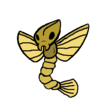
Fin Burz
Status: Extinct
progenitor: Longtail Burz
-> Swimming Burz
While some of the long-tailed Burz evolved better gliding wings, some of them have taken a different route. The membranes on their wings thicken, and secrete a water resistant gel, which enables them to dive deeper, and even use their new wings as rudimentary flippers. A similar protective membrane grows over their eyes to allow for better underwater vision.
Swimming Burz
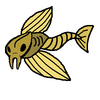
Swimming Burz
Status: Extinct
progenitor: Fin Burz
-> Aqlurz
-> Longfang
Aqlurz

Aqlurz
Status: Extinct
progenitor:
-> Toothed Aqlurz
-> Herbivorous Aqlurz
Toothed Aqlurz

Toothed Aqlurz
Status: Extinct
progenitor: Aqlurz
-> Grey Aqlurz
-> Blue Aqlurz
-> Deep Aqlurz
Grey Aqlurz

Grey Aqlurz
Status: Possibly Endangered?
progenitor: Toothed Aqlurz
-> Unknown
Blue Aqlurz

Blue Aqlurz
Status: Extant
progenitor: Toothed Aqlurz
-> Unknown
Deep Aqlurz

Deep Aqlurz
Status: Extant
progenitor: Toothed Aqlurz
-> Unknown
Herbivorous Aqlurz

Herbivorous Aqlurz
Status: Extinct
progenitor: Aqlurz
-> Tuatara Aqlurz
Tuatara Aqlurz

Tuatara Aqlurz
Status: Extant
progenitor: Herbivorous Aqlurz
-> Unknown
Longfang

Longfang
Status: Extant
progenitor: Swimming Burz
-> Unknown
Felg Evolution

Skrelp Evolution

Fin Skrelp

Fin Skrelp
Status: Extinct
progenitor: Skrelp
-> Proboscis Screlp
Fin Skrelps, as the name imply, grew fins. Said fins were of great use, allowing them to more easily navigate in the water.
Proboscis Skrelp

Proboscis Skrelp
Status: Extinct
progenitor: Fin Skrelp
-> Paddle Skrelp
Proboscis Skrelps facial tendrils grew and fuse into a long proboscis that allowed them to eat from below the surface, protecting from the Burz.
Paddle Skrelp

Paddle Skrelp
Status: Extinct
progenitor: Proboscis Skrelp
-> Purple Skrelp
-> Poison Skrelp
-> Green Skrelp
A enlarged, paddle-like tail has enabled the Skrelp to swim faster.
Purple Skrelp

Purple Skrelp
Status: Extinct
progenitor: Paddle Skrelp
->
A certain population of Skrelps has developed a different pigmentation. The purple skrelp are far more visible from above and are decimated by the leaf-sitting Horned Burz due to their tendency to remain still on leaves spotting prey. As a result, the population of purple skrelp develop stubbier dorsal fins and longer probosci, diving deeper in response to the disturbance in the surface tension by an attacking Burz.
Poison Skrelp
Poison Skrelp
Status: Extinct
progenitor: Paddle Skrelp
-> ???
Due to not being able to slip away from the Felg as easily, certain Skrelp have been developing a counter-measure to stop the problem at its source. Organs which appear as white spots on the skin act as a means of storing toxins naturally produced by the skrelp's body functions. Upon death, large amounts of toxin are released into the skrelp's body, making it deadly to eat.
Green Skrelp
Green Skrelp
Status: Extinct
progenitor: Paddle Skrelp
-> Land Skrelp
Another branch of skrelp emerges. Their skin responds to pain (such as caused by latched on felg) by manifesting bright, slightly luminescent purple spots. They also grow too big for burz to grab.
Land Skrelp
Land Skrelp
Status: Extinct
progenitor: Green Skrelp
-> Finned Skrelp
-> Burrowing Skrelp
-> Terrestrial Skrelp
Some of the the larger branch of Skrelp find algae is not enough to satiate them. They begin to venture onto the surface to search for larger plant life, slithering around slowly.
Finned Skrelp
Finned Skrelp
Status: Extinct
progenitor: Land Skrelp
-> ???
Some Skrelp have developed a second pair of fins by their rear, their current finds seem to have a few strengthened lines of their body Though useless currently, It does not affect their population this variant often stays in the water however
Burrowing Skrelp
Burrowing Skrelp
Status: Extinct
progenitor: Land Skrelp
-> Scrall
Land skrelp burrow into the soft land. Nose atrophies entirely, fins grow smaller. Reliance upon atavistic sensory tendrils increase.
Terrestrial Skrelp
Terrestrial Skrelp
Status: Extinct
progenitor: Land Skrelp
-> Nose Skrelp
-> Clawed Skrelp
Terrestrial Skrelp develop stronger, thicker pectoral fins, giving them faster movement on land.
Nose Skrelp
Nose Skrelp
Status: Extinct
progenitor: Land Skrelp
Big green has mouth under nose now. Tendrils return. Nose grows thicker and stronger for defence. Didn't last very long.
Clawed Skrelp
Clawed Skrelp
Status: Extinct
progenitor: Land Skrelp
-> Krelp
Land skrelp develop small claws on their fins. They have the twofold usage of allowing manoeuvrability in things such as climbing and as a small measure of defence.
Scrall Evolution
Scrall
Status: Extinct
progenitor: Land Skrelp
-> Spiral Scrall
-> Capped Scrall
Some of the Land Skrelp have started hanging around some of the early plantlife Others do venture to the surface at times, Most of these variants have shells and a hardened self lubricating skin to protect them from the heat of the sun, This variant are primarily herbivorous
Capped Scrall
Spiral Scrall
Crawl Scrall
Sand Scrall
Krelp Evolution
Fern Evolution

Thungus Evolution
